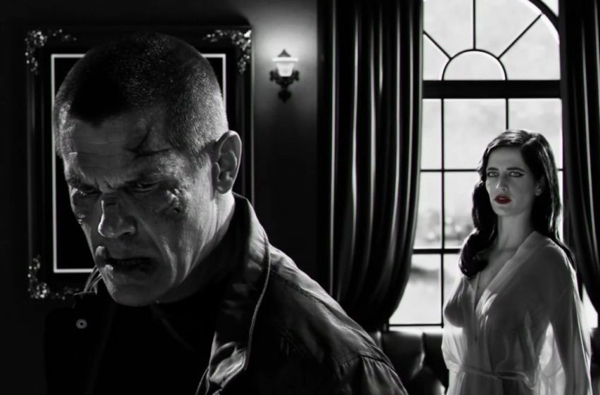Movie review by Greg Carlson
In 2005, “Sin City” exploited the possibilities of green screen in a manner that felt fresh and exciting, marrying computer generated imagery to the performances of Robert Rodriguez and Frank Miller’s game cast. Faithfully replicating the stylized, monochromatic panels of Miller’s cult comic book series, the film’s design was exciting and novel. At the time, I wrote “Seldom has a movie recreated the particular experience of reading comic books,” and compared to most of the films based on graphic fiction, only Edgar Wright’s “Scott Pilgrim vs. the World” has since surpassed the cinematic representation of the comic medium’s unique properties explored in the original “Sin City.”
What a huge disappointment, then, to discover that the anticipated sequel is such a deflating and dispiriting letdown. Titled “Sin City: A Dame to Kill For” and using Miller’s yarn of the same name as one of its principal storylines, the follow-up, as Nathan Rabin argues in his “Dissolve” commentary, “makes its predecessor seem much worse by association” and “calls into question whether ‘Sin City’ was any good at all, or whether the novelty of its visuals and storytelling merely masked a howling nothingness at its core.” Rabin’s critical annihilation of “A Dame to Kill For” lands squarely on what he sees as the movie’s hatefulness and stupidity, but plenty of fuel could also be added to the pyre regarding the leaden pacing and numbing repetitiveness.
Miller’s hard-boiled neo-noir voiceover, meant to pay homage to the slang-infused tough talk of classic pulp detective and crime fiction, is delivered without a single hint of humor or self-awareness, and the result is a tone deaf litany of misogynist cliches presumably reflective of Miller’s own regressive attitudes about gender. Abandon all hope that the filmmakers could be sophisticated enough to use the pulp format to deconstruct chauvinistic attitudes that fail to account for women as real human beings. The use of classic “narrating I” belongs exclusively to the men until late in the game, when Jessica Alba’s haunted stripper Nancy — following some painful self-mutilation — goes on a revenge-fueled murder spree.
That Nancy’s inner thoughts are expressed to the audience at all is something of a surprise. That those thoughts are only shared once Nancy begins behaving like Mickey Rourke’s violence-prone behemoth Marv is less suprising. From returning veterans like Alba, Rosario Dawson, and Jaime King to new recruits such as Lady Gaga, Jamie Chung (replacing Devon Aoki as Miho), and Juno Temple, Rodriguez and Miller include a significant number of women in the cast. The women of Basin City, however, exist only in positions subordinate to or dependent upon the men who aim to protect them — unless, of course, they are emasculating punishers.
The most important woman in “A Dame to Kill For” is Eva Green’s femme fatale Ava Lord, a one-time lover of the Marv-esque Dwight (Josh Brolin). Ava’s reappearance in Dwight’s life calls up old demons he had hoped to keep at bay, and the outcome of their entanglement can be guessed even if one has no previous experience with Miller’s source material. Green somehow manages to rise above the phony dialogue, a feat unrealized by Brolin, Joseph Gordon-Levitt, Powers Booth, and a barely present Bruce Willis. She almost looks like she is capable of having fun in a universe where that concept seems forbidden by every law of (un)civil society and human nature.
